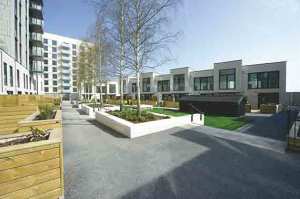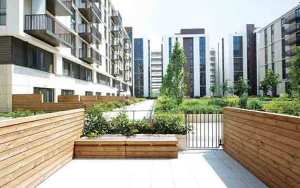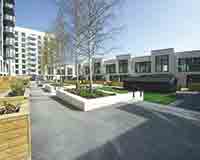 Multi-tenure is a new buzzword for residential developers – but to some in the industry, it is the latest version of a phenomenon that began a quarter of a century ago.
Multi-tenure is a new buzzword for residential developers – but to some in the industry, it is the latest version of a phenomenon that began a quarter of a century ago.
Section 106 of the 1990 Planning Act has fuelled 25 years of council planners’ ambitions, evident across London, to co-locate social rent and privately owned units within a scheme.
Shortly after the millennium, the Network Housing Association development of the old Victoria bus garage in Pimlico – embracing private owner-occupiers, social housing and shared ownership (along with a supermarket) – created what some regard as London’s first true multi-tenure residential development, long before the term became popular.
In today’s more complicated landscape, multi-tenure is almost de rigueur in new residential development, but the 2015 interpretation is evading any one-size-fits-all model.
“You can’t just say ‘social’ and ‘private’ now, as there’s such a spectrum of tenures,” says James Pargeter, head of residential projects at Deloitte Real Estate. “Even private ownership ranges from ordinary to oligarchs.”
He and almost every other industry insider accepts that, as has been the case for years, private housing for sale remains the most commercially viable development lynchpin in prime, central and outer London. Paddington Basin, East City Point at Canning Town, Brent Cross and the Biscuit Factory in Bermondsey are examples.
But while the traditional route begins with private sales with affordable following, the new game in town – as demonstrated by the Queen Elizabeth Olympic Park’s East Village – is the creation of build-to-rent PRS blocks as the leading element of a multi-tenure development.
“For developers used to building private homes first and getting off-plan sales to prove demand and satisfy investors, a PRS element with 100-plus units sold at the outset would be useful. It would provide income and residents, making the rest viable,” says Pargeter.
But he says the difficulty in today’s buoyant London market is margin. “How many developers would sell 100 mid-cost units at a discount to one PRS buyer, instead of 70 or 80 higher-spec units to owners or individual investors with no discount?”
For this reason, Knight Frank director Tim Treadwell believes a multi-tenure scheme could well be led by a PRS block rather than private individual units – but just not in central London. “PRS works best in mid- to lower-value locations, which is why the majority of activity in the sector is from the edge of Zone 2 outwards,” he says.
The use of PRS to promote multi-tenure is endorsed by Countryside’s chief executive, Ian Sutcliffe. His company has built PRS units for 50% of Liverpool’s NGV scheme, where it has de-risked the development to such a degree that it “allows a broad range of tenures to be offered” – and he believes a similar approach could work in parts
of London.
On top of its innovation and front-loading income for the scheme, the PRS element could also be eligible for funding under the government’s £2bn build-to-rent programme.
However, involving PRS would mean an end to what remains one of the most idealistic elements of multi-tenure development since the 1990s – “pepper-potting”, the seamless mixing of different tenure properties throughout a development. This was favoured by council planners during the early days of s106 agreements, but has not been tested with PRS.
“The PRS element should be separated out so it’s in a stand-alone block,” says Treadwell. ”This is important to [institutional] investors as it gives them control, particularly from a management point of view.”
Pepper-potting is now at a crossroads. On the one hand, Countryside’s Sutcliffe proudly says his schemes remain “tenure-blind”, with open market owner-occupied, Help to Buy owner-occupied, social rented and shared equity units cheek-by-jowl to create “socially sustainable communities”.
And Marc von Grundherr of Benham & Reeves Residential Lettings – which manages key worker and private units side by side at Imperial Wharf in Fulham and Beaufort Park in Colindale – says “there are no issues at all”.
But, on the other hand, Philip Waterfield of Strettons chartered surveyors – advising Triathlon Homes at East Village – is adamant that “a mix of tenures is generally avoided by all”.
He says private owners do not like pepper-potting (“it’ll normally reduce values”), while housing associations worry that it increases estate management problems and costs.
At its most extreme, the growing rejection of pepper-potting was seen last spring in the “poor doors” debate, which concerned insensitive entrance designs at some high-end prime London schemes segregating private from affordable residents, to the annoyance of social housing campaigners and politicians ranging from Ed Miliband to Boris Johnson.
“Design will mature as people see the old stereotypes are outmoded,” says Deloitte’s Pargeter. “Families and young singles alike rent nowadays, many people own, but that includes the super-rich and the not very well-off.
“That changing world is why multi-tenure is important – and complicated.”
 Queen Elizabeth Olympic Park
Queen Elizabeth Olympic Park
If one scheme epitomises 21st-century multi-tenure development, it is the Queen Elizabeth Olympic Park’s East Village (pictured above and left), where there are 2,818 homes in a mix of private and affordable tenures.
Some 1,439 private units are PRS owned by Qatari Diar and Delancey. Affordable units are owned by Triathlon Homes in a joint venture with East Thames Group and South Housing Group housing associations – they have 1,379 homes, made up of a mix of 348 shared ownership/shared equity, 356 intermediate rent and 675 socially-rented flats.











